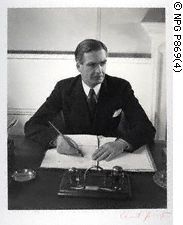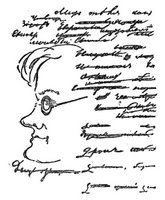PERSIAN SABER RATTLING OVER THE GULF: A COMMENT
"His remarks came a day after Mohammad Reza Rahimi, Iran’s first vice-president, warned that the country would not allow “even one drop of oil” to flow through the strait should the west impose oil sanctions on Tehran. Mr Rahimi’s comments caused a brief rise in the price of oil on Tuesday.
Washington yesterday warned Iran against any interruption to traffic through the waterway. “The free flow of goods and services through the Strait of Hormuz is vital to regional and global prosperity,” said Commander Amy Derrick Frost, a spokeswoman for the Bahrain-based US Navy Fifth Fleet.
“Anyone who threatens to disrupt freedom of navigation in an international strait is clearly outside the community of nations. Any disruption will not be tolerated.”
Some 13 to 15 supertankers pass through the strait every day, most of them heading towards Japan, South Korea, India and China. The US Navy patrols the waterway and analysts believe Iran would not be able to shut it down.
Tehran began a 10-day naval exercise on Saturday in the Gulf and the Strait of Hormuz, in a clear warning of the disruption the Islamic regime could cause to the world economy.
Iranian analysts believe the recent threats are an attempt by Tehran to prevent the European Union from extending sanctions to oil sales and the country’s central bank. France, Germany and the UK are pushing for an embargo on Iranian oil exports to Europe, although several countries, including Greece, have reservations. EU foreign ministers are due to discuss the embargo on January 30.
An Iranian reformist foreign policy website, irdiplomacy, said the exercises were a reminder that Iran’s army and elite Revolutionary Guards were capable of “cutting off the lifeline of the Arabs and the west'".
Monavar Khalaj & Najmeh Bozorgmehr, "Iran naval chief adds to Straits Tension." The Financial Times. 28 December 2011, in www.ft.com.
"There is nothing new about Iran’s threat to close the Gulf, but it does need to be put in context. Iran is reshaping its military forces to steadily increase the threat to Gulf shipping and shipping in the Gulf of Oman, It also is gradually increasing its ability to operate in the Indian Ocean.
This increase in Iranian capability is almost certainly not designed to take the form of a major war with the US and Southern Gulf states, which could result from any Iranian effort to truly close the Gulf. It does, however, give Iran the ability to carry out a wide range of much lower level attacks which could sharply raise the risk to Gulf shipping, and either reduce tanker traffic and shipping or sharply raise the insurance cost of such ship movements and put a different kind of pressure on the other Gulf states and world oil prices.
Any such Iranian actions do not have to be tied in any way to predictable attacks at or near the Strait of Hormuz. They could occur anywhere in the Gulf and in the Gulf of Oman. Iran could deny many such forms of attack, claim rogue operations or that they were provoked by US or other Gulf country actions, or keep the level of such attacks so low that it would be difficult to respond with high levels of force and Iran could keep exporting its own oil.
Moreover, Iran’s growing long-range missile forces, and movement towards a nuclear weapons capability will give it an increasing capability to compensate for its aging and low capability regular naval and air forces with a far more threatening level of deterrence.
It is also important to note that the current flow of oil and gas exports through the Gulf is critical to the global economy, as well as that of a US that must pay rising world oil prices in a crisis. The US Department of Energy projects that this global strategic dependence on the secure and steady flow of Gulf energy exports will increase steadily through 2035 – as far in the future as the Department makes projections.
Equally important, the same US Department of Energy projections make it clear that the US will not achieve any meaningful improvement in energy independence through 2025, although it will make limited reductions in total imports and increases its own conventional and unconventional liquids production....
In 2011, total world oil production amounted to approximately 88 million barrels per day (bbl/d), and over one-half was moved by tankers on fixed maritime routes. By volume of oil transit, the Strait of Hormuz leading out of the Persian Gulf and the Strait of Malacca linking the Indian and Pacific Oceans are two of the world's most strategic chokepoints.
The international energy market is dependent upon reliable transport. The blockage of a chokepoint, even temporarily, can lead to substantial increases in total energy costs. In addition, chokepoints leave oil tankers vulnerable to theft from pirates, terrorist attacks, and political unrest in the form of wars or hostilities as well as shipping accidents which can lead to disastrous oil spills.
n average, 14 crude oil tankers per day passed through the Strait in 2011, with a corresponding amount of empty tankers entering to pick up new cargos. More than 85 percent of these crude oil exports went to Asian markets, with Japan, India, South Korea, and China representing the largest destinations.
At its narrowest point, the Strait is 21 miles wide, but the width of the shipping lane in either direction is only two miles, separated by a two-mile buffer zone. The Strait is deep and wide enough to handle the world's largest crude oil tankers, with about two-thirds of oil shipments carried by tankers in excess of 150,000 deadweight tons.
Closure of the Strait of Hormuz would require the use of longer alternate routes at increased transportation costs. Alternate routes include the 745 mile long Petroline, also known as the East-West Pipeline, across Saudi Arabia from Abqaiq to the Red Sea. The East-West Pipeline has a nameplate capacity of about 5 million bbl/d. The Abqaiq-Yanbu natural gas liquids pipeline, which runs parallel to the Petroline to the Red Sea, has a 290,000-bbl/d capacity. Additional oil could also be pumped north via the Iraq-Turkey pipeline to the port of Ceyhan on the Mediterranean Sea, but volumes have been limited by the closure of the Strategic pipeline linking north and south Iraq".
Anthony Cordesman, "Iran and the threat to 'close' the Gulf," Center for Strategic and International Studies.. 30 December 2011, in www.csis.com.
The Persian scare tactics of the last few weeks over threatening to close the Persian Gulf have manifestly failed. As it seems increasingly clear that both the Americans and the European Union will indeed place more economic sanctions upon the regime of Mullahs in Tehran 1. Which is not to deny, pace Anthony Cordesman's analysis that the Persians could indeed make things very difficult indeed for the Americans, et. al., if they endeavored to try to close the straits. Merely as has been proved in the past, `a la the Iran-Iraq War from 1987-1988, a determined American effort will by its very nature stop the regime in Tehran in its tracks in terms of endeavoring to stop traffic in the Gulf 2. What is needed is a firm, direct and loudly proclaimed policy that the West will not under any circumstances stand for any closure of the Persian Gulf by the regime in Persia. So far the American administration appears to be following this line. Unlike some commentators (Ray Takyh being the chief of these), I am of the opinion that the regime in Persia is in military and strategic terms a 'paper tiger' pur et simple 2. If the West takes and keeps to a tough line, the regime of Mullahs in Tehran will bluster but do nothing. As the ever wise, Mr. Max Boot has commented recently in the American broadsheet the Wall Street Journal:
"Closing the strait is not nearly as easy as Adm. Habibollah Sayari, commander of the Iranian Navy, would have it. He said that closing the strait is "as easy as drinking a glass of water." Actually it would be about as easy as drinking an entire bucket of water in one gulp" 3.
1. James Blitz & Guy Dinmore, "Italy urges gradual Iran [Persia] oil ban." The Financial Times. 6 January 2012, in www.ft.com; Tentative agreement: EU moves forward on Iran oil embargo." Der Spiegel.
5 January 2012, in www.spiegel.de.
2. For the 1987-1988 American policy, see: Max Boot & Bradley Russell, "Iran won't close the strait of Hormuz." The Wall Street Journal. 4 January 2012, in www.wallstreetjournal.com. On Ray Takeyh, "The Self-limiting Success of Iran [Persian] Sanctions." The Council on Foreign Relations. November 2011, in www.cfr.org.
3. Ibid.











0 Comments:
Post a Comment
<< Home